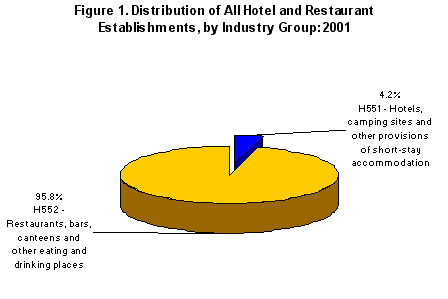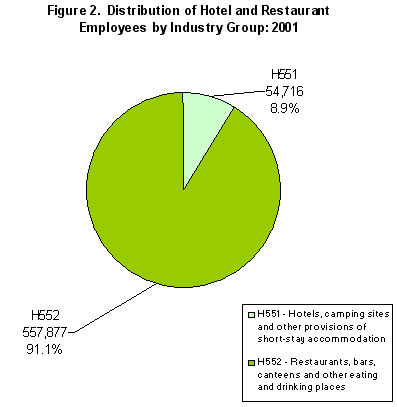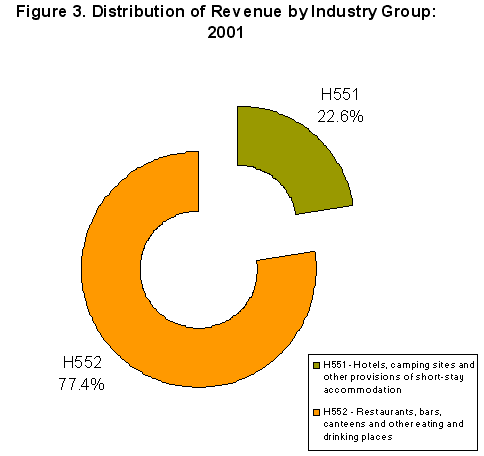Restaurants, bars, canteens and other eating and drinking places dominated the hotels and restaurants sector
-
The 2002 Annual Survey of Philippine Business and Industry (reference year - 2001) covered a total of 87,924 hotel and restaurant establishments. Of the total figure, 85,568 establishments or 97.3 percent had an average total employment (ATE) of less than 20. Only 2,356 establishments or 2.7 percent had an average total employment of 20 and over. (Tables 1-3)
-
Most of these establishments, 95.8 percent, were restaurants, bars, canteens and other eating and drinking places (PSIC H552) while hotels, camping sites and other provisions of short stay accommodation (PSIC H551) made up 4.2 percent of the total count. Figure 1 shows the distribution of all hotels and restaurants by industry group.

Employment is also bigger in restaurants, bars, canteens and other eating and drinking places
-
Hotel and restaurant establishments generated jobs to 612,594 workers. Of the total work force, 486,480 (79.4%) were paid employees and 126,113 (20.6%) were working owners and unpaid workers.
-
Top employers in the sector were restaurants, bars, canteens and other drinking places which employed 557,877 (91.1%) workers while hotels, camping sites and other provision of short-stay accommodation employed only 54,716 workers (8.9%). Figure 2 displays the distribution of employment by industry group.

Average monthly compensation per employee is higher in hotels and similar establishments
-
Compensation paid to employees by hotel and restaurant establishments amounted to almost P 23.41 billion in 2001 which was equivalent to an average monthly compensation of P4,010 per paid employee.
-
Industry wise, restaurants, bars, canteens and other eating and drinking places paid the highest to its employees with an estimated amount of P 18.32 billion or 78.3 percent while hotels, camping sites and other provisions of short-stay accommodation paid P 5.09 billion or 21.7 percent to its employees.
-
Highest earners were employees in hotels, camping sites and other provisions of short-stay accommodation with an average monthly pay of P 8,413 per paid employee whereas workers in restaurants, bars, canteens and other eating and drinking places received lower average monthly pay of P 3,501. (See Table R.1. Selected Ratios for All Hotel and Restaurant Establishments)
Total revenue earned amounted to P 109.67 billion
-
Total revenue generated by the sector in 2001 amounted to P109.67 billion. Among the industry group, restaurants, bars, canteens and other eating and drinking places earned the highest revenue amounting to P84.84 billion or 77.4 percent of the total revenue while hotels and similar establishments contributed only P24.8 billion or 22.6 percent. Figure 3 illustrates the distribution of revenue by industry group.

Operational cost totaled to P 73.82 billion
-
Excluding compensation paid to employees, total cost spent to operate and maintain hotels, restaurants and similar establishments reached P 73.82 billion in 2001.
-
The biggest spender in the sector were restaurants and similar establishments, which incurred P 57.39 billion or 77.7 percent. On the other hand, the remaining 22.3 percent or P 16.4 billion were spent by hotels, camping sites and other provisions of short-stay accommodation.
-
Revenue per worker, a measure of labor productivity was estimated at P 0.179 million. Hotels and similar establishments exhibited a higher labor productivity at P 0.453 million. On the other hand, restaurants and other eating and drinking places had a lower productivity at P 0.152 million.
TECHNICAL NOTES
Scope and Coverage:
The 2002 Annual Survey of Philippine Business and Industry (ASPBI) formerly known as Annual Survey of Establishments (ASE) was conducted to collect information on the structure and trends of economic activities in the entire country for the year 2001. Covered were establishments engaged in economic activities as defined under the 1994 Philippine Standard Industrial Classification (PSIC). These establishments were classified into 14 sectors, one of which is on hotel and restaurant establishments (Sector H). The sector is composed of establishments engaged in two industry group namely, hotels, camping sites and other provisions of short-stay accommodation (H551) and restaurants, bars, canteens and other eating and drinking places (H552).
All hotel and restaurant establishments nationwide with average total employment (ATE) of 200 and over were covered on a 100 percent basis and those with ATE less than 100 were selected using simple random sampling.
Response
A total of 302 or 88.56% responded out of the 341 samples drawn for the sector. Adjustments for non-response were made through imputations.
Concepts and Definition of Terms
Establishment Establishment is an economic unit, which engages under a single ownership or control, i.e. under a single legal entity, in one, or predominantly one kind of economic activity at a single fixed location.
Economic activity or business is the activity of the establishment as classified under the1994 Philippine Standard Industrial Classification (PSIC). The main activity refers to the activity that contributes the biggest or major portion of the gross income or revenue of the establishment.
Total Employment is the number of persons who worked in or for the establishment as of November 15, 2001.
Paid employees are all persons working in the establishments receiving pay as well as those working away from the establishment when paid by and under the control of the establishment. Included are persons working as full-time or part-time and those employees on sick leave, paid vacation or holiday. Excluded are consultants, home workers and workers receiving commission only.
Unpaid workers include working owners who do not receive regular pay, apprentices and learners without regular pay, and persons working without regular pay for at least one third of the working time normal to the establishment.
Salaries and wages are payments in cash or in kind, prior to deduction for employee?s contribution to SSS/GSIS, withholding tax, etc. Included are total basic pay, vacation, sick, maternity leave pay, overtime pay, and other benefits.
Revenue refers to cash received and receivables for goods sold and services rendered.
Cost refers to all expenses excluding compensation incurred during the year whether paid or payable. Valuation should be at market price including taxes and other charges, net of discounts, rebates, returns and allowances. Goods received from and services rendered by other establishment of the same enterprise are valued as though purchased
Gross additions to fixed assets refer to the cost of acquisition of fixed assets acquired in 2001 less the value of sales of fixed assets during the year.
Fixed assets are physical assets expected to have productive life of more than one year and intended for use and/or being used by the establishment. Included are land, buildings, fixtures, machinery, tool, furniture, office equipment, vehicles, and the like.
Capital expenditures refer to the cost of acquisition of fixed assets acquired in 2001 whether or not full payments have been made.
Subsidies are special grants in the form of financial assistance or tax exemption or tax privilege given by the government to develop an industry or production and to protect it against competition.
Inventories refer to stocks of goods owned by or under the control of the establishment as of a fixed date, regardless of where the stocks are located. Valuation should be at current replacement cost in purchaser?s price at the indicated dates. Replacement cost is the cost of an item in terms of its present price rather than its original price.
Change in Inventories as a derived indicator is computed as the value of ending inventory less the value of beginning inventory.
Value Added is the total revenue plus capital expenditures (own account) plus change in inventories less total cost (net of indirect taxes and interest).
Source: National Statistics Office
Manila, Philippines
